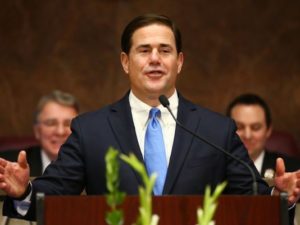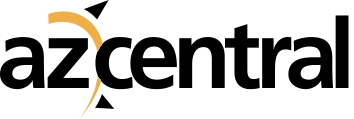
Gov. Doug Ducey said his 15 proposals for education are aimed at one goal: closing the achievement gap for poor and minority students. Now the question is how to pay for it.
But while Ducey may be showing his heart, he’s refused to say where his head is on finding more funding. And without more money than Ducey offers to spend in his proposed budget, many believe moving the needle on the achievement gap is impossible.
“It comes down to politics versus policy,” said Rep. Randy Friese, D-Tucson. “What the governor is doing is politics. He’s talking about all the wonderful things he wants to do, but he can’t fund them. Policy is about coming up with ideas that are doable, fundable.”
What Ducey did, didn’t say
Ducey in his State of the State address and budget proposal suggested one path to close the gap — or at least the beginnings of one based on available revenue.
Ducey’s proposals include a 0.4 percent raise for teachers over each of the next five years, $1,000 signing bonuses for teachers willing to work in low-income schools, $10 million for full-day kindergarten programs at low-income schools and an additional $38 million for schools that excel. Altogether, Ducey is proposing an additional $96.6 million for schools.
Scarpinato said Ducey has traveled the state over the past two years visiting schools, many in low-income neighborhoods.
“He’s really seen what’s going on in those areas, the things teachers and principals are doing to beat the odds,” Scarpinato said. “These are the places that need our help and where we really can make an impact with the resources we have.”
Ducey, who ran on a pledge not to raise taxes, did not mention in either his address or his budget any proposal for additional school revenue. He’s repeatedly refused to say whether he will support extending or expanding the voter-approved education sales tax, Proposition 301. The tax, which generates about $600 million a year, expires in 2021.
According to polls, Arizona voters are increasingly demanding more money for education. A September poll from The Arizona Republic/Morrison/Cronkite News found nearly three-fourths of Arizona voters surveyed said the state is not spending enough money on K-12 public district and charter-school students. The narrow passage of Proposition 123 in May did little to change that belief.
Businessman Phil Francis, former PetSmart CEO, is an advocate for full-day kindergarten. Despite a proposal for only partial funding, he said he’s “delighted” with Ducey’s vision.
“I think the list represents the structure of a good plan,” he said. “I think you are setting the stage with the right elements.”
Arizona currently funds 2.5 hours a day of kindergarten. Many districts offer full-day programs, but cover the additional hours either with their own money or with voter-approved overrides.
Ducey proposed rolling out additional funds over two years to cover the cost of full-day kindergarten at schools in which 90 percent or more of the students qualify for free or reduced-price lunch. This would cover about 9 percent of Arizona’s kindergarten students.
Francis said he understands why Ducey didn’t address Prop. 301.
“First he got a plan; next he’s doing the money,” he said. “As a business person, I never went out and got the money first. Any rational person would get the plan and a structure first, and then execute it.”
Lisa Graham Keegan, executive director of A for Arizona, a group organized under the Arizona Chamber Foundation, said the programs Ducey proposes to fund flow together into schools in a way that will most benefit students and teachers.
“It’s been a while since we’ve had a big vision from a governor about specifically what he expects,” Keegan said. “I welcome it. These are the right signals.”
Finding the gap
The focus on Arizona’s achievement gap has intensified during the past year as business, education, political and philanthropic groups have worked together to determine how to best improve Arizona’s education system.
These groups, which span the political spectrum, agree that Arizona schools need more money. Most have embraced the categories Expect More Arizona concluded had the most impact on students’ long-term success, including teacher pay, full-day kindergarten, third-grade reading proficiency, eighth-grade math proficiency and higher-education participation.
Ducey’s budget proposal mimics those categories.
The numbers themselves don’t suggest goals for improvement — although stakeholders are working to develop those goals. The metrics also currently don’t suggest how much money is needed to move the needle.
“There is pretty broad consensus that these are the right indicators to focus on,” said Erin Hart, chief operating officer with Expect More Arizona.
She said the achievement gap in Arizona is most often due to income and ethnicity. For example, passage rates for third-grade reading, according to 2016 AzMERIT test data, show success for:
- 41 percent of all students.
- 57 percent of white students.
- 30 percent of Latino students.
- 30 percent of African-American students.
- 29 percent of economically disadvantaged students.
- 21 percent of homeless students.
“Income is now really coming to the surface as one of the most important factors in how kids are going to do,” Hart said. “Families with higher levels of income see higher achievement.”
Pushing the money conversation
A growing number of education and political leaders are demanding Ducey either start talking about additional revenue or invest all of the available money into teacher salaries.
“We need to have as big an impact as possible,” said David Lujan, with the Arizona Center for Economic Progress. “So much research and so many involved in education will tell you the most important thing you can do is have a qualified, certified teacher in every classroom. We don’t have that.”
Joe Thomas, president of the Arizona Education Association, the union that represents teachers, said the proposed teacher raises aren’t enough to move the bar.
“Arizona ranks near the bottom in teacher pay,” Thomas said. “Raising salaries by 0.4 percent does not meaningfully address this crisis or help the thousands of students left without a qualified teacher in the classroom.”
Two recent teachers of the year, along with the advocacy group AZ Schools Now, have asked Ducey to give teachers a 4 percent raise, which would cost $134 million. They suggest Ducey could find the money by freezing prior corporate tax cuts, among other areas.
Friese, the Tucson lawmaker, said if Ducey really believes all of these ideas are vital, he must talk about raising enough revenue to pay for them. Some business leaders, lawmakers and advocacy groups have begun talks about expanding Prop. 301 from 0.6 cents to a full cent per dollar. Expanding it would generate an additional $400 million annually, or about $1 billion total each year.
“I was on my feet during the State of the State applauding the governor’s ideas,” Friese said. “But let’s talk about quality instead of quantity. The ideas are good, but you have to be able to follow through.”
Friese has introduced a bill to ask voters to expand Prop. 301 to a full cent. Rep. Kirsten Engel, D-Tucson, has a bill that asks the Legislature to expand it without voter approval, requiring three-fourths approval from lawmakers. So far, only Democrats have signed on in support of the bills. Neither is scheduled for a public hearing, which is required for the bills to advance.
Rep. Paul Boyer, R-Phoenix, chairman of the House Education Committee, falls somewhere in the middle of the debate. He said he fully supports Ducey’s budget proposal.
“If we don’t have a goal, we’re not going to achieve anything,” Boyer said. “Now we have a goal. Now we know at least what to work towards.”
But he also said he would like to see the Prop. 301 bills get a debate and be put up for a vote this year.
Chances are slim.
Both Senate President Steve Yarbrough, R-Chandler, and House Speaker J.D. Mesnard, R-Chandler, during an Arizona Chamber of Commerce and Industry event said the Legislature should discuss Prop. 301. But both agreed this likely isn’t the year for a decision.
“We have some time for Prop. 301 to run its course,” Yarbrough said. “It’s more than a year exercise, probably. I don’t think it would even be 2018.”
“We can certainly begin the conversations now. Whether it’s 2018 or 2020 remains to be seen. What it looks like remains to be seen,” Mesnard said. “I’m skeptical frankly that something will culminate in 2018.”
Ducey hasn’t publicly stated any timeline, though his staff said he is aware of the need for action.
“The governor didn’t invest the time and money he did on Prop. 123 to see a cliff in a few years. We are having discussions with the education community, with the business community,” Scarpinato said at a meeting on the budget earlier this month. “The governor’s goal is we want to be successful with whatever we do. We’ll keep you updated as those conversations continue.”
-Originally published by Alia Beard Rau, Arizona Republic 1/29/17 at 5:00 pm


